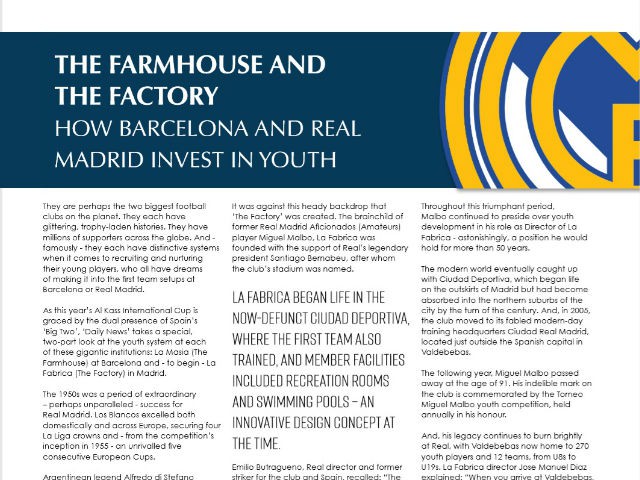February 18, 2020
THE FARMHOUSE AND THE FACTORY HOW BARCELONA AND REAL MADRID INVEST IN YOUTH
They are perhaps the two biggest football clubs on the planet. They each have glittering, trophy-laden histories. They have millions of supporters across the globe. And - famously - they each have distinctive systems when it comes to recruiting and nurturing their young players, who all have dreams of making it into the first team setups at Barcelona or Real Madrid.
As this year’s Al Kass International Cup is graced by the dual presence of Spain’s ‘Big Two’, ‘Daily News’ takes a special, two-part look at the youth system at each of these gigantic institutions: La Masia (The Farmhouse) at Barcelona and - to begin - La Fabrica (The Factory) in Madrid.
The 1950s was a period of extraordinary – perhaps unparalleled - success for Real Madrid. Los Blancos excelled both domestically and across Europe, securing four La Liga crowns and - from the competition’s inception in 1955 - an unrivalled five consecutive European Cups.
Argentinean legend Alfredo di Stefano would develop a lethal understanding with Hungarian hotshot Ferenc Puskas as Madrid swept all before them in the late-50s. And yet, even as they did so, there was a recognition that homegrown potential needed to be developed to play alongside such imported greats as di Stefano and Puskas.
It was against this heady backdrop that ‘The Factory’ was created. The brainchild of former Real Madrid Aficionados (Amateurs) player Miguel Malbo, La Fabrica was founded with the support of Real’s legendary president Santiago Bernabeu, after whom the club’s stadium was named. La Fabrica began life in the now-defunct Ciudad Deportiva, where the first team also trained, and member facilities included recreation rooms and swimming pools – an innovative design concept at the time.
Emilio Butragueno, Real director and former striker for the club and Spain, recalled: “The old Ciudad Deportiva had a central building. You would enter down a hallway to the right for the first team squad, to the left was for the Castilla (Reserve) team. At the end of the hall there was a very large locker room for all of the lower division teams.”
The ‘Factory’ system arguably reached its zenith in the 1980s when many La Fabrica graduates helped the club to a glittering array of silverware, including five top-flight titles in a row and back-to-back UEFA Cup triumphs in 1985 and 1986. Among those homegrown heroes were ace marksman Butragueno, sweeper Manuel Sanchis, attacking midfielder Martin Vazquez, right midfielder Michel and striker Miguel Pardeza.
Throughout this triumphant period, Malbo continued to preside over youth development in his role as Director of La Fabrica - astonishingly, a position he would hold for more than 50 years.
The modern world eventually caught up with Ciudad Deportiva, which began life on the outskirts of Madrid but had become absorbed into the northern suburbs of the city by the turn of the century. And, in 2005, the club moved to its fabled modern-day training headquarters Ciudad Real Madrid, located just outside the Spanish capital in Valdebebas.
The following year, Miguel Malbo passed away at the age of 91. His indelible mark on the club is commemorated by the Torneo Miguel Malbo youth competition, held annually in his honour.
And, his legacy continues to burn brightly at Real, with Valdebebas now home to 270 youth players and 12 teams, from U8s to U19s. La Fabrica director Jose Manuel Diaz explained: “When you arrive at Valdebebas, the locker rooms for the youngest players come first, until you get to the last one which is for Real Madrid Castilla. For the players, moving forward through the locker rooms helps them realise how they are advancing.”
The interior design of Valdebebas mirrors the path laid out for Madrid’s youngsters, who aim to work their way up through a pyramid system before reaching the very top and making into Real’s first XI, the road to success being one where dedicated toil is the very least that is expected.
Current Real and Spain winger Lucas Vazquez is a product of La Fabrica. He joined the system in 2007 at the age of 16, and made his debut for the club’s C-Team in the 2010-11 campaign. He then worked his way into the reserve side, helping them return to the Spanish league’s second tier after a fiveyear absence in 2012. Vazquez went out on loan to Espanyol in 2014 before returning a year later, making his first team bow for Real that September. “The pyramid closes in more as you go towards the top,” he revealed. “It gets harder.”
La Fabrica still plays a vital role for those that the club regard as the cream of their own crop. There are five other graduates alongside Vazquez in the current Real squad – striker Borja Mayoral, fellow forward Mariano Diaz and defenders Achraf Hakimi, Dani Carvajal and Nacho.
And, as well as continuing its rich tradition of developing playing talent, aspiring coaches also learn their trade at La Fabrica. In recent years, these have included former Real luminaries such as Raul, Xabi Alonso and Roberto Carlos. One way or another, ‘The Factory’ production line continues to roll.

